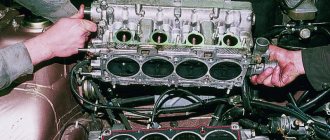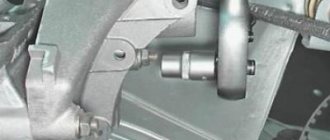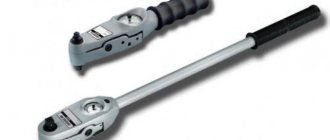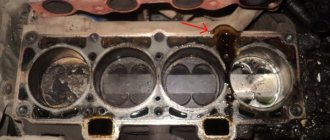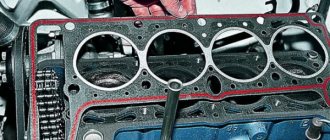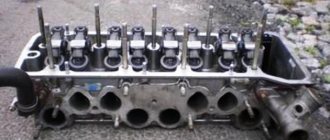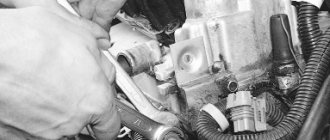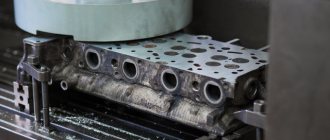Repair manual for VAZ 2110, 2112, 2111 (Lada 110)
4.22.
Cylinder head parts: 1 – cylinder head; 2 – intake camshaft; 3 – oil seal; 4 – exhaust camshaft; 5 – camshaft bearing housing; 6, 8 – sealing rings; 7 – guide pipe; 9 – block head cover; 10 – bracket for fastening the wiring harness; 11 – plugs; A – distinctive belt of the intake camshaft. Head 1 (Fig. 4.22) of the cylinder block is common to four cylinders, cast from aluminum alloy, with tent-shaped combustion chambers. The inlet and outlet channels are located on different sides of the block head. The valves are arranged in a V-shape in two rows: inlet on one side, exhaust on the other.
Sintered valve seats and brass valve guides are pressed into the head. The inner diameter of the guide bushings is (7±0.015) mm, the outer diameter (for bushings supplied as spare parts) is 12.079–12.090 mm and 12.279–12.290 mm (bushing increased by 0.2 mm).
The valves are similar in design to engine valves mod. 2110, but have a smaller diameter of plates and rods. The intake valve has a disc diameter of 29 mm, and the exhaust valve has a disc diameter of 25.5 mm. The diameter of the intake valve stem is (6.975±0.007) mm, the exhaust valve is (6.965±0.007) mm.
One spring is installed on each valve. The length of the spring in the free state is 38.19 mm, under load (240±9.6) N [(24.5±0.98) kgf] should be 32 mm, and under load (550±27.5) N [( 56.1±2.8) kgf] – 24 mm.
The valves are driven by camshaft cams through cylindrical hydraulic pushers located in the guide holes of the cylinder head along the axis of the valve holes. Hydraulic tappets automatically eliminate the clearance in the valve mechanism, and therefore, when servicing the vehicle, there is no need to check and adjust the clearance in the valve mechanism.
4.23. Suspension of the power unit with engine mod. 2112: 1 – bracket on the right side member of the body; 2 – lower limiter of the pillow; 3 – right support cushion; 4 – upper limiter of the pillow; 5 – pillow fastening nut; 6 – spacer washer; 7 – support fastening nut; 8 – right support bracket; 9 – rear support rod; 10 – rear support bracket; 11 – left support cushion; 12 – nut with washer; 13 – left support bracket; 14 – front support bracket; 15 – front support rod
Oil for the operation of hydraulic tappets is supplied from the lubrication system through a vertical channel in the cylinder block to a channel in the cylinder head near the 5th mounting bolt (see Fig. 4.23), and then through the upper channels made on the lower plane of the bearing housing. Oil is supplied through the same channels to lubricate the camshaft journals. A check ball valve is located in the vertical channel of the cylinder head, which prevents oil from draining from the upper channels after stopping the engine.
The valves are driven by two camshafts: intake and exhaust. The shafts are cast from cast iron and are equipped with five bearing journals, which rotate in slots made in the cylinder head and in one common camshaft bearing housing. To increase wear resistance, the working surfaces of the cams and the neck under the oil seal are bleached. To distinguish the intake camshaft from the exhaust camshaft, a distinctive belt A is made on the intake shaft near the first support.
The shafts are kept from axial movements by thrust collars located on both sides of the front support. The front ends of the camshafts are sealed with self-clamping rubber seals. The rear holes, located along the axis of the shafts in the cylinder head and bearing housing, are closed with rubberized cap plugs.
Checking the technical condition and repairing the cylinder head are similar to those described for the engine mod. 2110.
You will need: a device for compressing valve springs, a device for pressing out and a mandrel for pressing in valve stem seals, a 10mm socket wrench, a 10mm hexagon, a screwdriver, tweezers.
1. Remove the cylinder head from the engine (see “Removing the cylinder head on a vehicle”).
Removal
1. Drain the coolant from the engine (see “Coolant - replacement”).
If disassembling the cylinder head is not required
(for example, to replace the cylinder head gasket), it should be removed as an assembly with the camshafts, bearing housing, fuel rail, oil pressure and camshaft position sensors.
4. Disconnect the upper mounting rod of the power unit from the cylinder head bracket (see “Upper mounting rod of engines 2112 and 21124 (16v)”).
13 mm socket wrench
Unscrew the three nuts securing the rod bracket.
6. Remove the bracket from the studs.
8. 10 mm
Unscrew the bolt securing the ground wire tip and disconnect it from the block head.
9. 13 mm
Unscrew the nut securing the tip of the negative terminal wire of the battery and remove the tip from the stud.
10. To avoid damaging the sensor connectors, disconnect the wires from the coolant temperature sensors of the engine management system (see “Coolant temperature sensor - check and replacement”) and from the temperature indicator (see “Coolant temperature sensor - check and replacement” ), as well as from the camshaft position sensor, if we remove the cylinder head assembly (see “Camshaft position sensor - check and replacement”).
13 mm socket wrench
Unscrew the two nuts securing the thermostat housing.
12. Remove the thermostat housing from the cylinder head studs and, without disconnecting the hoses, move it to the side.
13. Remove the sealing gasket.
10mm hex wrench
unscrew the ten bolts securing the head to the cylinder block in the specified sequence.
Sequence of loosening the head bolts
15. Remove the head from the cylinder block assembly.
. or with the camshafts removed.
16. Remove the cylinder head gasket.
17. In order not to lose it, we remove the two guide bushings from their seats in the cylinder block.
Do-it-yourself repair of the cylinder head (cylinder head) on a 16-valve VAZ-2112
Cars of the VAZ-2112 family were produced with one of two 16-valve engines - 21124 and 21120. The displacement of these engines is different, and only one part called the “cylinder head” is used - it is designated by the numbers 2112-1003011. There are rumors that the cylinder head from the 21120 engine does not fit the 24th engine, but a reverse replacement is possible. However, there is only one article in the spare parts catalog, and it is suitable for two motors at once. Next we consider what actions to repair the VAZ-2112 cylinder head you can perform yourself. We will only talk about 16-valve engines.
An example of dismantling is shown in the video. Let's see.
Dismantling the cylinder head
First of all, to get to the cylinder head, you need to remove the cylinder head cover. For different 16-valve engines, this operation is different, and the cover part numbers also look different: 2112-1003260 (-10) and 21124-1003260.
Engine cover VAZ-21124 (1.6 l)
You will also need to remove the timing belt - there are no differences between different engines.
Let's look at how the exhaust manifold can be detached from the cylinder head. On engine 21120:
- Remove the exhaust pipe of the muffler: unscrew two nuts 1 (key “13”), remove the clamping bar, unscrew six nuts 2 (key “14”) and dismantle, not forgetting to turn off the oxygen sensor. The photo shows three of the six nuts.
Elements of the exhaust pipe
Everything important is under the screen
Now we will talk about engine 21124:
- Disable both oxygen sensors. We unscrew the three nuts securing the protective screen (with a 10mm wrench) and disassemble the bracket by unscrewing the four nuts with a 13mm wrench.
How to disassemble the mounting bracket
Operation with additional muffler
Here we believed that the VUT hose was disconnected from the intake module. Finally, the spark plugs are unscrewed on any of the engines (a “16” tubular wrench).
The tightening torques for the mounting screws are given in another text. In general, on VAZ-2112 hatchbacks, cylinder head repairs begin by replacing the “extended” screws with new ones. The length should be 95mm or less.
The order of unscrewing (left) and tightening the mounting screws
Cleaning valve channels
To remove any valve, you will need to remove the camshaft. All screws on the bearing housing must be unscrewed evenly and tightened with a force of 10 N*m. The hydraulic compensator can be removed with a magnet, and then the valve is desiccated by compressing the spring with a puller (see photo).
There may be carbon deposits in the valve channels. It is cleared:
- Flat screwdriver;
- Sanding felt.
Grinding is carried out as follows: a rubber pipe is placed on the valve, a paste with diamond chips is applied (one drop), then the valve is pressed into the channel and scrolled. It will also be possible to change the valve stem seals (2112-1007026). You can’t do this without a special puller.
On any car, including the VAZ-2112, cylinder head repair comes down to cleaning and checking, as well as correcting geometry defects. In the latter case we are talking about milling. The presence of cracks and chips is a reason for replacement, not repair.
A small photo report
A burnt valve is immediately visible.
One valve burned out in cylinder 2
Carbon deposits were found in each valve channel.
Carbon layer in the cylinder head channels
Repair : cleaning all channels, replacing the valve with lapping. Direct repair of the VAZ 2112 cylinder head will require several operations that require some special equipment. Of course, this is not possible at home, and car enthusiasts simply replace worn parts. Next, we will consider the process of repairing the block head, as well as some of the nuances associated with this work.
Stages of block head repair
Before proceeding directly to the cylinder head repair process, it is worth noting that the head must be completely disassembled and all the necessary spare parts purchased. Let's consider the process of complete overhaul of the cylinder head.
Washing and crimping
The process of washing automobile spare parts with hot kerosene
In order to wash the head, it must be completely disassembled, that is, all parts that can be easily removed must be dismantled. For a complete wash you need 12 liters of hot kerosene. At car services, this is done using a sprayer that supplies liquid under pressure. This way, all the dirt and remaining metal shavings are washed away. The washing is carried out until the cylinder head is completely clean.
The process of crimping the cylinder head
Crimping is a process in which the integrity of a part is checked. Pressure testing can be carried out in two ways, which are basically similar. The first is to close all the cracks and fill the part with water. If there is water leaking or leaking somewhere, then the integrity has been compromised and repairs are necessary. The second method is to close all the cracks and immerse the head in an aqueous solution. It will be immediately obvious where the part is depressurized. If the integrity of the head is damaged, it must be restored.
Installation
1. Wash the cylinder head from dirt and deposits with kerosene or diesel fuel.
2. Remove any remaining oil and coolant from the threaded holes of the cylinder block (under the cylinder head bolts).
3. We clean the mating surfaces of the head and cylinder block from the remains of the old gasket, and degrease the surfaces with a solvent.
Warning! Always use a new gasket when installing the cylinder head. Oil contact with the gasket surface is unacceptable.
4. Install the head guide bushings into the seats of the cylinder block. We place the gasket on the cylinder block, and the guide bushings should fit into the corresponding holes in the gasket.
5. Install the head on the cylinder block. By slightly moving the head from side to side, we ensure that the guide bushings fit into the corresponding recesses of the head.
Warning! Reuse of cylinder head bolts is only permitted if their length does not exceed 100 mm
6. Using a caliper or a bench ruler, measure the length of the bolts. Bolts longer than 100 mm are replaced.
7. Before installation, dip the threaded part of the bolts into engine oil and let the oil drain, waiting for about half an hour.
8. Install the head mounting bolts into the holes of the head. Using a torque wrench, tighten the head mounting bolts in three steps - first with a torque of 20 Nm (2 kgfm), then turn the bolts by 90° and then turn the bolts again by 90°. In this case, we follow the order indicated in the photo.
Head bolt tightening sequence
We perform further engine assembly in reverse order.
Conclusion
Thus, a major overhaul of the cylinder head of the 16-valve VAZ 2112 engine is being carried out. This process at a car service center will take 1-2 days, but in his garage a car enthusiast can spend much more time, since the lack of tools will affect him. Thus, it is recommended to carry out cylinder head repairs at car repair shops, where everything will be done much faster and with better quality. Of course, this will hit your pocket, since high-quality and major repairs of this part will cost on average about 7,000-10,000 rubles. along with spare parts.
Source
Tool for the job
Before proceeding directly with the replacement, you need to collect all the necessary tools and materials:
- A set of keys of various diameters “10”, “13”, “17”, “21”.
- Screwdriver.
- Pliers.
- New coolant.
- Container for coolant.
- Clean rags.
- New consumables (depending on the purpose of the work being performed - approx.).
- Anti-recoil shoes.
For ease of work, it is best to use an inspection hole or a lift.
Removing the cylinder head on a VAZ-2112 - work procedure
Before you begin, make sure that the vehicle is on a level surface, the handbrake is on, and the wheel chocks are placed under the rear wheels.
Attention! Work must be carried out only on a cold engine.
- First of all, disconnect the negative terminal from the battery.
- In a pre-prepared container, drain the antifreeze through the drain hole on the heater radiator.
- Using a “10” wrench, unscrew the four bolts securing the decorative engine casing.
Mounting points for the decorative cover of the 124 motor. Editor's car in the photo!
We disconnect each wire from the spark plug in turn.
Pay attention to the amount of traces of corrosion
Idle speed sensor close up on an editorial VAZ-2112
Pull out the cable according to the arrows.
We remove the receiver to the side (it will be either steel or plastic. For example, on a 124 engine the receiver is made of plastic). The photo shows engine 21120
Using two wrenches, unscrew the fuel line
Place the loosened bolts in a safe place.
Inspect the hose for damage and replace if necessary.
Please note that there is coolant in the thermostat, so do not get scalded.
The location of the bolts is indicated by a marker.
The next step you will need to remove the timing belt. You can read about how to carry out this work correctly in this article. Timing belt tension is discussed here.
- When the belt is removed, it is necessary to remove 2 camshaft pulleys. To prevent them from turning, we hold them, unscrew the fastening bolts, and then the pulleys themselves can be removed. (Don’t forget to remove the keys on the grooves of the shanks on the shafts - approx.).
Carefully remove the dismantled pulleys to the side.
The bolts are marked with a red marker.
Unscrew it as indicated by the arrows.
The cylinder head has been removed and cleaned.
Camshaft replacement process
Camshafts with gears and fasteners
In order to install camshafts on the VAZ-2112 16 valves, they must first be dismantled. Like any spare part, they are installed in the reverse order from disassembly.
So, let's look at the step-by-step process of removing and installing the intake and exhaust camshaft.
Removing camshafts
- To begin with, as with any repair operations, it is necessary to remove the “minus terminal” from the battery.
- Remove the timing belt cover.
After unscrewing the mounting bolts indicated in the diagram, remove the timing cover
Unscrew the fastening nuts and remove the valve cover.
Disconnect the emergency oil pressure sensor
Scheme for dismantling and tightening the camshaft bearing housing bolts
You need to be careful with the camshaft plugs; if you install them incorrectly, oil will leak out. If you don’t notice it in time, you’ll shorten the engine’s lifespan or end up in need of a major overhaul.
Remove the two rear cylinder head plugs
We remove the camshafts from their seats
Remove the seals from the camshaft. If it does not come off, carefully cut it or pry it off with a screwdriver.
Installation of camshafts
Now that everything is removed, you can proceed to installing new camshafts on the car:
- Lubricate the cams and shaft support journals with engine oil.
Lubricate the camshaft journals and cams with engine oil.
The intake camshaft is shown on the left and the exhaust camshaft on the right.
How to apply sealant to the camshaft bearing housing cover
We press new oil seals onto the camshafts
Choice
Original catalog numbers: inlet - 2112-1006015, outlet - 2112-1006014. Each camshaft costs an average of about 3,000 rubles.
Nuances
When installing the bearing housing and cylinder head, do not apply sealant that contains silicone. This is due to the fact that the motor heats up, and accordingly the sealant heats up, which releases vapors that can get into the cylinders and further through the system. You should use a sealant whose instructions or packaging indicate that it is safe for the oxygen sensor.
Tuning yellow iron
The VAZ 21124 includes “yellow iron” tuning, in which stabilizers (for agility), reinforcements and braces (for road stability) are installed.
However, be careful with counterfeits of these parts; at worst, they will damage the car, and at best, you will be throwing away a lot of money. Feel like a real circuit racing driver with the VAZ 21124 hatchback. All you need is to install additional parts: a nameplate (symbols) on the handle of the car, neon lighting under the bottom of the car, an air intake on the hood and roof. The installation of front and rear bumpers with an aerodynamic body kit will add power to the car.
Main signs for dismantling the cylinder head
The manufacturer did not provide any regulations for replacing auxiliary parts of the cylinder head, but there are some signs that will still require dismantling it.
- Presence of mechanical traces on the cylinder head.
- The presence of engine oil or antifreeze leaks at the junction of the cylinder head with the block.
- If white steam comes from the exhaust pipe , this will mean that antifreeze has got into the cylinders and there is no way to do this without removing the cylinder head.
- Emulsion foam on the expansion tank cap indicates exhaust gases entering the cooling system.
- in the coolant - this indicates that the system is not tight.
- on the engine oil dipstick , which tells us that there are traces of antifreeze (antifreeze) in the oil. The work will require removal of the cylinder head.
Meet the model
Do-it-yourself decarbonization of valves
With the new engine, the unit was given the name VAZ 21124, this machine intensively fights against the ecology of the external environment. In addition to everything, when the car starts, the traction at the bottom has become noticeable, and the engine now runs calmer, without large jumps. We often hear questions from owners of 16-valve engines: “What needs to be done to prevent the valves from bending in the piston?” In Veil 21124, this task will not exist for you, in the bottom of the piston there are holes and sports shafts that keep the rise of the piston under control, and don’t let the knocking and noise of the VAZ 21124 engine frighten you, this is its normal environment.
Upgrading a car is currently the most important goal for every modern and self-respecting driver. Tuning VAZ 21124 contains configurations of both the internal and external features of the car. Replacing the cylinder head gasket of a VAZ 2114 8 8 Kalina valve with your own hands). Styling the exterior of a car includes installing a body kit on the bumper fenders, sills, hoods and doors, this gives your car a special, sporty look, and also improves its aero performance. To create a sports car VAZ 21124, it is impossible to do without replacing body elements with plastic material. Plastic parts reduce the weight of the car, making it easy to drive on the road. The final feature of a sports car is the installation of alloy wheels and sports tires.
